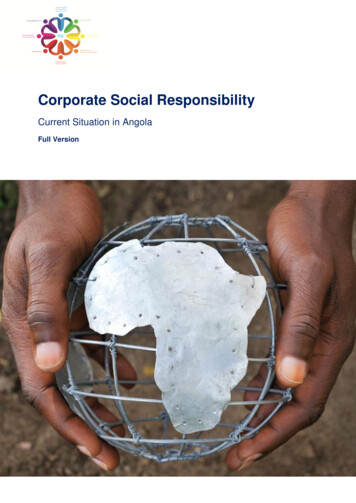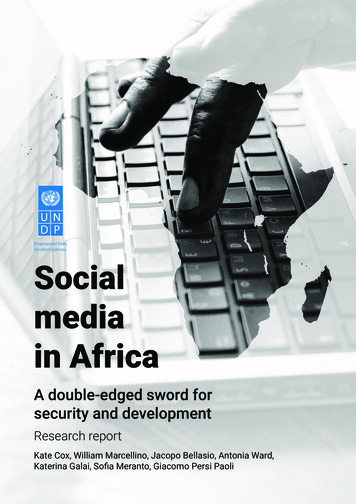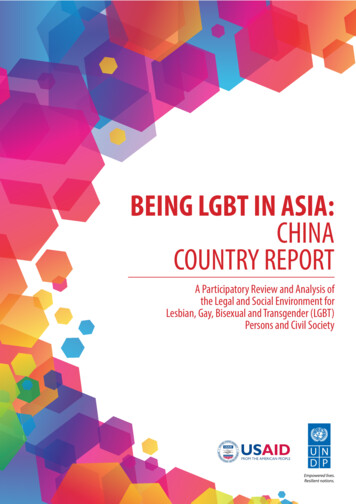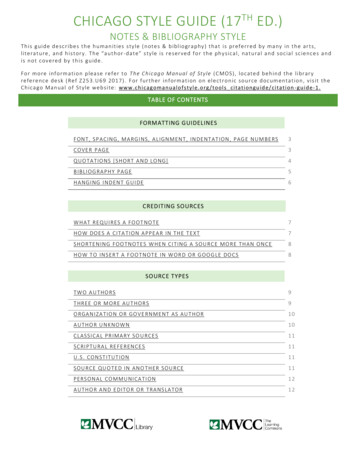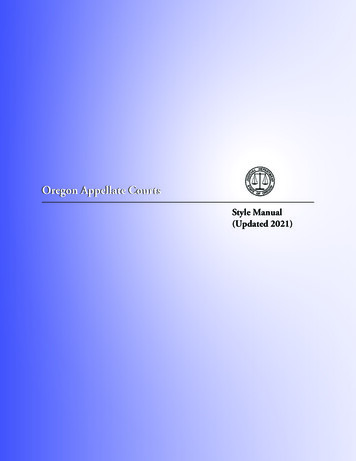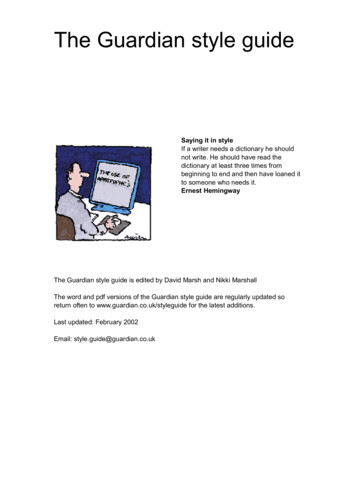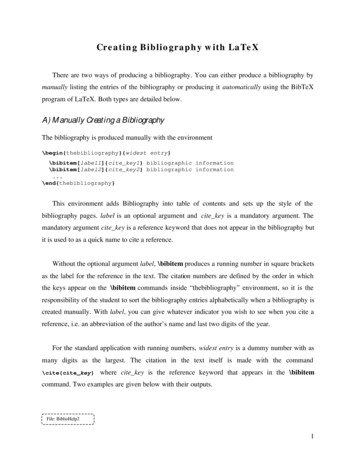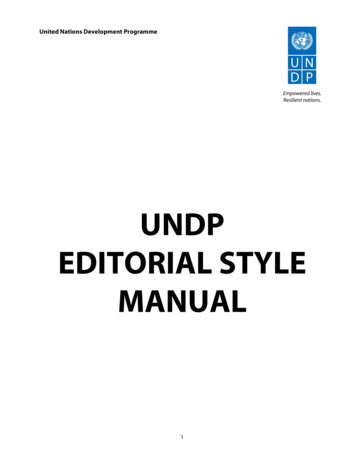
Transcription
United Nations Development ProgrammeUNDPEDITORIAL STYLEMANUAL1
2
UNDP Editorial Style ManualPublished by the Communications ClusterBureau for External Relations and Advocacy, New YorkLast updated: January 20143
INTRODUCTIONThe UNDP Editorial Style Manual is intended to offer guidance on grammar, spelling and punctuation toensure clarity and consistency in UNDP for print and online internal and external communications,covering publications, speeches and statements, press releases and media advisories, social media,multimedia products, including photo captions. All staff members and consultants are encouraged tofamiliarize themselves with the Editorial Style Manual. Effective communication of UNDP’s message relieson consistent use of language across the organization.Together with other writing and publishing guides available in the UNDP Communications Toolkit, theUNDP Editorial Style Manual is intended as a resource to allow all of us at UNDP to speak as one in ourcommunications.Key resources:1.2.3.4.UN Editorial ManualUNDP Brand ManualUNDP Guidelines for PhotographyUNAIDS HIV and AIDS Terminology5. Unicef Reporting Guidelines to Protect Children4
Table of ContentsPage7ABBREVIATIONS AND ACRONYMSAbbreviationsCommon abbreviationsAcronyms8CAPITALIZATIONProper nouns and adjectives and recognized geographical namesNames of organizations9FORMATTING A DOCUMENTFontSentencesParagraphsChapter headingsSubheadingsListsReferences and bibliographiesUse of ibid.Footnotes: When to use footnotes and endnotesPlacement of footnotesEndnotesFootnotes in digital erOmit needless wordsOverused words and phrases111214NAMESNames of countriesPermissible abbreviationsAlphabetizationEnglish usageDisputed territoriesStyles of addressNames of personsNUMBERSNumbers expressed in wordsOrdinal numbersNumbers expressed in figuresMillionsBillions and trillionsCurrencyTime of dayDatesCollective datesDecades5
171922CenturiesPercentagesRangesTwo numbers occurring togetherSeries of numbers to which different rules applyFractionsNumbers in references to parts of documents or publicationsAbbreviationsWhole numbersPUNCTUATIONSingle quotation marksDouble quotation marksBullets, dashes, French and Spanish punctuation marksApostropheItalicsCommaColonDashPoints of ellipsisSPELLINGDoubling final consonantsPlurals for words of foreign originHyphenated wordsPendent hyphensHyphenating groups of wordsDivision of wordsSENSITIVE LANGUAGEAvoiding sexist and racist languageANNEXES25 I: Useful spellings for UNDP35 II: Acronyms42 III: UNDP Offices worldwide46 IV: HIV-related language guide6
ABBREVIATIONS AND ACRONYMSAbbreviationsAbbreviations should not be used for words or titles—of articles, books, organizations or people—that occur onlyonce or twice in a text. If a title occurs many times in a document, a short form may be used. The full title shouldbe given the first time it appears and repeated only where necessary for clarity. Thereafter, a short title may beused unless there is a risk of ambiguity. Examples of short titles are: the Assembly, the Council, the Commission,the Committee, the Special Committee.“United Nations” may be abbreviated in information materials in English but not in formal documents. The form“ONU” is acceptable in French in certain texts. The following titles should not be abbreviated in running text:Economic and Social Council, UN General Assembly, UN Secretary-General, Security Council.Common abbreviationscf. compareNB nota bene (‘please note’)e.g. for exampleNo. numberet al. and others (note punctuation)p. pageetc. et ceterapp. pagesi.e. that is to sayVol. Volume or vol. volumeAcronymsAcronyms are formed from the initial letters of other words e.g. UNDP. They have the advantage of brevity andthe disadvantage of needing to be memorized and giving a document the appearance of ‘alphabet soup’.Acronyms are written entirely in capital letters, without full stops or periods, in United Nations usage. So: UNDPand not U.N.D.P.A title or name of an organization (e.g. World Food Programme) or programme (e.g. United Nations Volunteers)or an institution (e.g. Department for International Development) that recurs should normally be written in fullthe first time it is mentioned and should be followed by the acronym between parentheses; thereafter, only theacronym should be used consistently throughout the text.Acronyms should not be used for names that rarely appear in a text unless the acronym is more familiar than thefull name, e.g.:UNICEF (United Nations Children’s Fund)UN Women (United Nations Entity for Gender Equality and the Empowerment of Women).If the text is very long and contains many acronyms, a list of acronyms should be inserted either at the beginningor the end of a publication; the names should still be written out on first use in the text.It is especially important to explain acronyms in documents that are to be translated, since translators may not befamiliar with UNDP or even United Nations terms. See the UN Term database if you have questions on UnitedNations acronyms or terminology.Acronyms derived from languages other than the language of the document should be avoided. However, if theyare used, the full name in the original language should be supplied.Acronyms should normally be used without the definite article, e.g.:The cooperation of WHO was sought.UNDP and ILO jointly sponsored a workshop.However, exceptions are made, such as: the OAU; the ICC (International Criminal Court); the WB (World Bank).7
Do not use an apostrophe to form the plural of abbreviations and acronyms (write NGOs, not NGO’s; PSAs, notPSA’s). It is incorrect.Acronyms should never be hyphenated at the end of a line. A list of frequently used acronyms is provided inAnnex III. .CAPITALIZATIONGenerally, capitalization should be avoided except where necessary, according to the guidelines below.A list of commonly used words that for which the UN requires initial capital letters and those that do not isprovided in Annex II.Official titles of conferences and years should be capitalized regardless of whether or not the conference hasbeen held at the time of writing.EXAMPLE:A draft programme was prepared for the International Year for the Eradication of Poverty.Proper nouns and adjectives and recognized geographical namesInitial capital letters should be used for proper nouns and adjectives and for recognized names or titlesEXAMPLES:Dag Hammarskjöldthe Government of FranceAsian, Icelandicthe English ChannelWorld Wide Web (or ‘the Web’)Yunan ProvinceWeb editorMount Everestsouthern AfricaLake TiticacaSouth AfricaSouth China SeaMexico Citythe Danube Riverthe city of Chicagothe Rhine and Danube riverPlace de la ConcordeThe word state is capitalized in specific references when it refers to a country but not when referring to a part of afederal entity, such as the state of New York or the states of Brazil, or as an adjective, as in state school.Names of organizationsWhen citing the names of organizations, organs and institutions of any country, the national usage should befollowed. It should also be followed for the titles of officials and styles of address.EXAMPLES:Agence France-Presse (AFP)Fédération Internationale de Football Association (FIFA)When an organization has English as one of its official or working languages, the English spelling andhyphenation that it uses for its own name and for the titles of its officials should be followed.Country specific institutions (e.g. L’Académie Française, Loya Jirga, Keidanren, etc.) and acronyms of worldrenowned institutions (NASA, FBI, CIA, etc.) should be left as is and explained in brackets. .8
FORMATTING A DOCUMENTThe Executive Board documents must strictly follow the rules for UN Document submission with regards toformatting, number of words and length. See examples of properly formatted UN Documents on the UNDPExecutive Board website.FontFor all official communications, especially UNDP publications, Myriad Pro 10 pt font should be used. Alternativefonts can be used according to design needs for publications. For more information on branding designrequirements please refer to the UNDP Brand Manual.SentencesA single space is used after each period or full stop to separate sentences.ParagraphsIt is preferred style for paragraphs to be separated by a single empty line, except in cases where space limitationsmake this impractical. In such cases, the first paragraph in a chapter or article or following a subheading is notindented, and all other paragraphs begin with an initial indent. Paragraphs on websites are never indented.An initial large capital, or drop cap, is often used at the beginning of an article or chapter, as part of a designelement, not for regular Microsoft Word documents. As this technique is not as effective if the first word consistsof only one or two letters, the first sentence may require reworking so that it begins with a longer word. Also forreasons of appearance, a drop cap should never be preceded by quotation marks.Try to avoid what typesetters refer to as widows and orphans—a short single line at the bottom or top of acolumn or page.Chapter headingsIn UNDP publications, the usual style used for chapter headings is to capitalize the first word, unless the headingcontains a proper noun or a book title, e.g. Facts for Life.SubheadingsAs mentioned above, the first paragraph following a subheading should not be indented, although subsequentparagraphs should begin with an indent.ListsIdeally, lists should be used with simple bullet points to indicate each item. Numbering can also be used, if thenature of the document or specific content (such as pointers or checklists) requires it. Numbering and letteringare used often for official UN/UNDP documents or legal papers.References and bibliographiesFor detailed information on references, bibliographies, comparing ibid. and op. cit and how to format footnotesand references to a variety of different sources, please refer to the relevant section of the United Nations EditorialManual.In providing references, consistency of style is most important. In general, information is ordered in the followingsequence with the items separated by commas: author (first author listed, with last name first) or source, title(titles of articles or documents are enclosed in single quotes, book titles are italicized), editor(s), publisher, placeof publication, year of publication, pages cited. Such terms as ibid. and op. cit. are no longer italicized. For clarity,these terms are compared below.9
Use of ibid.Ibid. (the abbreviation for ibidem, meaning “in the same place”) refers to the work cited in the preceding footnoteor to the preceding work within the same footnote. The term should not be used when the preceding footnoteincludes more than one source.Ibid. is used when it is not possible to repeat footnote indicators (e.g. in documents and publications when therepeated reference is more than six double-spaced pages away from the first reference) and to replace thoseelements that are identical in the preceding footnote or the preceding work within the same footnote. It is neverused solely to replace the name of an author. When different works by the same author are cited in consecutivefootnotes, the author’s name is repeated in full each time.EXAMPLES:1United Nations, Treaty Series, vol. 75, No. 973.Ibid., vol. 2187, No. 38544.3Official Records of the General Assembly, Fifty-eighth Session, Supplement No. 20 (A/58/20), para. 239; and ibid.,Sixty-first Session, Supplement No. 20 (A/61/20), paras. 245 and 260.4Paul Kennedy, The Parliament of Man: The Past, Present, and Future of the United Nations (New York, RandomHouse, 2006).5Paul Kennedy, Preparing for the Twenty-first Century (New York, Random House, 1993).6Ibid.2Footnotes and textnotesFootnotes. In resolutions and decisions, all sources are cited in footnotes. In masthead documents (thosedocuments using the UN letterhead format at the top of the page), sales publications and reports issued assupplements to the Official Records, footnotes are used to cite: United Nations sales publications Reports of United Nations conferences Instruments issued in the United Nations or League of Nations Treaty Series Advisory opinions, judgments and orders of the International Court of Justice Documents and publications issued by other organizations and by Governments Books, periodicals and articles contained therein Working papers and research reports in a published series Unpublished papers and dissertationsFootnotes, text notes or references directly in the text. In masthead documents, publications andsupplements, references to newspaper articles, public statements, interviews, personal communications andmaterial on a website may be given in footnotes, text notes or directly in the text, as appropriate.Placement of footnotesFootnotes to items in the text are placed at the bottom of the page. Endnotes are not used. Footnotes to figuresand tables are placed directly below the figure or table. Footnotes to items in a boxed text contained in adocument or publication are normally placed within the box.Footnotes indicated by asterisks and other symbols are placed above footnotes indicated by numbers and lowercase letters when they appear at the bottom of the same page. For additional information, see Footnoteindicators/ Footnotes indicated by lower-case letters and Footnotes indicated by asterisks and other symbols.Footnotes in boxed summaries. Footnotes are not given for items in a boxed summary at the beginning of adocument if the items can be referenced in the main body of the text. When it is necessary to include a footnoteto an item in a boxed summary, the footnote is indicated by a lower-case letter and placed within the box.Text notes. In documents, publications and supplements to the Official Records, text notes are used to cite:10
United Nations documents Reports issued as supplements to the UN Official Records. Statements and oral reports made before a United Nations bodyEndnotes:Generally, endnotes are similar to footnotes except that they are just placed at the end of a document instead ofthe bottom of the page, as with footnotes.Footnotes in digital publicationsFor publications that are created from layout files for the print publication—PDF files—footnotes can appear innormal placements. When using apps for digital publications where there are not necessarily regularized pagenumbers, a footnote should follow the paragraph in which it is cited and be linked to the footnoted text. Thereader can then choose to click on the link to read the footnote and then go back to the regular text. .GRAMMARAmong/betweenUse between when referring to two parties. When referring to three or any number over three, use among.That/whichThe basic rule governing the use of that and which is: that introduces defining clauses, which are critical to the meaning of the sentence, and which introduces non-defining clauses, which provide additional clarification but are not mandatory tounderstand the meaning of the sentence.EXAMPLE:Each student made a list of books that had influenced her. The list refers not to books in a general sensebut only to books that had influenced her.Contrast with: I always buy his books, which have influenced me greatly.A quick way to note the difference between the two types of clauses is to remember that non-defining, or which,clauses need commas, and defining, or that, clauses do not.EXAMPLES:The dog that I saw yesterday came back to the house.Nations that ratify the Convention are obliged to protect people from maltreatment.That may be omitted in some cases; which is never omitted as it changes the meaning of the sentence.Note: The book I am reading for The book that I am reading.Whereas, This fact, which you admit, condemns you cannot be changed to This fact, you admit, condemnsyou.Less/fewerLess refers to quantity, fewer to number:“His troubles are less than mine” means that they are not so great.“His troubles are fewer than mine” means that they are not so numerous.11
In general, less is applied to mass nouns and fewer to count nouns. As the name implies, a count noun is a nounthat can be counted. A mass noun cannot be counted.EXAMPLES:There was less money available.There were fewer funds available.An exception to this rule is made in the case of time, money and distance, which always use less.EXAMPLES:The meeting lasted less than three hours.The town was less than four miles away.The total cost was less than I had expected.Omit needless wordsEvery word should serve a purpose. Also, some advice from Orwell’s essay, Politics and the English Language: Never use a long word where a short one will do. (See suggestions of short words below) If it is possible to cut a word out, always cut it out.Some examples:The question as to whetherwhetherThere is no doubt but thatdoubtlessHe is a man whoheThe reason why is thatbecauseIn spite of that fact thatalthoughThe fact that she had arrivedher arrivalAs to whetherwhetherAs yetyetEgypt is a country thatEgyptFirstly, secondly, thirdlyfirst, second, thirdoverly, thuslyover, thusOverused words and phrases:Instead oftryfacilityinsightfulroll outjump starthospital, prison, bathroom, etc.perceptiveintroduce, implementenergize, invigorate .NAMESNames of countriesIn United Nations terminology, country names have two forms. The full name, as used in formal documents, mustbe observed especially when dealing with UN Member States and UNDP Executive Board Members. The names to12
be used for all ordinary purposes are listed in Annex IV. Some of these short names may be abbreviated incertain circumstances, as explained below, but all the others should always be given in full.Permissible abbreviationsOnce the full name, such as the United Republic of Tanzania, has been mentioned, or where space is limited, forinstance in a table, the short form Tanzania may be used. Short forms such as Libya and Syria, United Kingdomand United States may be used, and the abbreviations UK and US may be used as adjectives and in tables.AlphabetizationCountries are usually listed in alphabetical order, which follows the normal word order of each name. TheRepublic of Korea, for instance, is listed under the letter R, not K. When several countries are given as examples inrunning text, they should also be alphabetized. Any exceptions to this practice should be explained.EXAMPLES:Cameroon, the Central African Republic, Côte d’Ivoire and Myanmar.English usageAs indicated in Annex III, some country names are preceded by the (as the Bahamas). The article is omitted in lists,tables and headings and, with the exception of the former Yugoslav Republic of Macedonia, countries arealphabetized without the. UN Protocol provides a continually updated list of official country names mesofcountries.pdfA country is treated as singular even when its name has a plural form: the Philippines is ; Trinidad and Tobagois . . .Common errors:The Netherlands: must use TheViet Nam: two words (in UNDP)The former Yugoslav Republic of Macedonia should never be shortened to Macedonia.Democratic People’s Republic of Korea not North KoreaRepublic of Korea not South KoreaDemocratic Republic of the Congo: must use theCôte d’Ivoire not Ivory Coast. Note the accented character.Kazakhstan, not KazakstanFor country names in the official UN languages consult UN Term (United Nations Multilingual TerminologyDatabase) maintained by the Terminology and Reference Section, Documentation Division, UN Department forGeneral Assembly and Conference Management, New York. The names are provided in the six official languagesof the United Nations. Revisions to the files are issued from time to time, please visit the UN Terminology websiteto learn more. [Go to the database. Under Subjects, select Country names. ]Disputed territoriesThe list below gives the currently accepted terms and additional important information for several geographicalareas of political sensitivity. The former Yugoslav Republic of Macedonia—if used in an alphabetical list, must be listed under letter ‘t’. occupied Palestinian territory (oPt)—note capitalization. Should not be referred to as a country, nor should itappear in a list of countries.13
Kosovo—should not be referred to as a country, nor should it appear in a list of countries. The name Kosovoshould always be annotated with the following footnote: Hereafter referred to in the context of UN Security CouncilResolution 1244 (1999).Therefore, when referring to UNDP’s presence around the world, please reference “ more than 170 countriesand territories ”Styles of addressIn a publication, it is preferable to use an adult’s first and last names on first reference without the honorificunless the person is a medical doctor (in which case use Dr. before the full name). In subsequent references usethe honorifics of Mr., Ms., Mrs., or Dr. (for medical doctors only) and the last name. For the names of children, usethe full name in first reference. The first name only may be used in subsequent references. Please see furtherinformation on referencing children in publications in the Unicef Reporting Guidelines to Protect Children.Names of personsCurrent UNDP Administrator Helen Clark should be referred to by her full name, or, in subsequent referenceswithin the same document as Miss Clark, as per her request. In the case of other women, you can use thehonorific Ms.Always check to make sure names are spelled correctly. For UNDP and the UN Secretariat headquarters staff,consult the UN Telephone Directory. Staff outside New York, however, cannot access this internal onlinedocument.For spelling of the names of permanent mission and delegation staff, consult the website maintained by theUnited Nations Protocol and Liaison Service.People’s names should be spelled identically in English, French and Spanish texts—do not translate them.Names should include any accents that are used in the original language.EXAMPLES:French: H.E. Mr. Mamadi TouréSpanish: H.E. Mr. Héctor Virgilio Alcántara MejíaPortuguese: H.E. Mr. Álvaro José Costa de Mendonça e MouraSlovakian: H.E. Mr. František Ružička .NUMBERSNumbers expressed in wordsIn general, numbers under 10 (one to nine) should be written in words. Numbers should also be spelled out in thefollowing contexts: at the beginning of a sentence; in approximate or isolated references to dimensions, weightsand measures in non-technical, non-statistical texts; in fractions in narrative text; and in reference to ages in nontechnical, non-statistical texts.Ordinal numbersOrdinal numbers indicate a position in relation to other numbers: first, second, third.Ordinal numbers are written when they exist as a single word: the second meeting of the day.Ordinals that would require two words are expressed as figures: the 24th day of the month.Please note that the ordinal form is not used when writing dates: 8 November, not 8th November.14
When a cardinal and an ordinal number are used in conjunction with the same noun, the ordinal always precedesthe cardinal: The first two programmes are to be completed this year.Numbers expressed in figuresNumbers between 10 and 999,999 should normally be expressed in figures. In addition, the following are alwaysexpressed in figures: percentages; ratios; results of voting; dates and time of day; numbers with decimal places;fractions; statistics; degrees; dimensions, weights and measures, except when they are obviously intended to beapproximate or in isolated references in a non-technical context; series of figures; document symbols; and pageand paragraph references.MillionsIn English, numbers in the millions should be written as follows: 15 million, 3.4 million, BUT 3,432,583 if you areusing an exact number.In UNDP, sometimes numbers in millions are rounded up to the nearest decimal point, especially when referringto funds, and depending on the type of product where these numbers appear (print, online, social media, etc.).EXAMPLES:3,432,583 can be expressed as US 3.43 million3,476,583 can be expressed as 3.48 million or 3.5 million3,432,583 can be rounded up to 3 millionBillions and trillionsInasmuch as the term billion is generally accepted throughout the world in the sense of a thousand million, itshould be so used in United Nations documents. If there is any possibility of confusion, the use of the term shouldbe defined in an explanatory note or in a footnote.CurrencyFunding references are almost always in US dollars except when referring to the Euro. In writing, please use thisformat for the first reference: US 20 million (NB: no spaces in between).Do not use USD. In subsequent references to the US dollar, the US need not be used, just the dollar sign ( ) as in 20 million.Time of dayReferences to the time of day using the 12-hour system should be made as follows: 9 a.m. (not 9:00 a.m.), noon(not 12 noon), 1:15 p.m., 3 p.m., 9:05 p.m., midnight.The time of day expressed in four figures using the 24-hour system should be written without punctuation, e.g.2100 hours, not 21.00 hours.DatesThe standard form for dates is day/month/year, for example: 2 January 2013. Do not use a comma after themonth. Forms such as 2/1/98 should be avoided because of differences in usage regarding the order of thenumerals indicating the day and month.Collective datesIn references to an inclusive period of two or more full years, the years are given in full and connected by a shortdash (–), called an en dash. For example: 1997–1998 (meaning the two-year period); 2001–2005; the annual15
average for the period 1975–1980. The forms 2013-4, and 2013-14 should NOT be used, nor should the formfrom 1995–2000. The phrase from 1995 to 2000 is acceptable.The form 2012/2013, using the slash, is appropriately used in describing academic years and fiscal years. In UNDP,this form is often used in annual reports because of UNDP’s financial accounting period.In references to an inclusive period of two or more days, the form 23 and 24 July, for example, should be used inrunning texts. Where space is limited, the form 23–24 July may be used.In references to a period of hours before and after midnight, a stroke (or slash) should be used between the twodates, for example, 23/24 July, during the night of 31 July/1 August.DecadesIn English, references to decades should be expressed in figures, for example, the 1990s, the mid-1990s (NOT thenineteen-nineties, the 90s or the 1990’s); in French, les années 90; in Spanish, el decenio de 1990.CenturiesReferences to centuries should be expressed as follows: in English, the 19th Century; in French, le XIXe siècle; inSpanish, el siglo XIX. Please note use of upper case for Century in English.PercentagesPercentages should be expressed in figures, e.g.15%. The % sign should only be used in tables, callouts,infographics, etc. In UNDP style, percent is written as one word, as opposed to two words in the Concise OxfordEnglish Dictionary.RangesWhen a quantity is expressed by two numbers indicating a range: If the name of the unit is written out, it should be given only once, after the second number, e.g. for10- to 15-year-olds; increases ranging from three to four percent a year; If the name of the unit is represented by a symbol, the symbol should always be repeated, e.g. a hightemperature of 63o– 70o (when denoting temperature, indicate Fahrenheit or Celsius); If the name of the unit is represented by a symbol or abbreviation consisting of a letter or letters, the symbolor abbreviation should be given only once if an en dash or hyphen is used to mark the range, e.g. it required15–20 kg of rice; The two numbers showing the range should be parallel in structure, e.g. from 3,430,700 to 4,000,000 units(NOT from 3,430,700 to 4 million units); To guard against any possible confusion, numbers should be expressed in full, whether in figures or inwords, when a range is indicated, e.g. it increased from 2 million to 5 million (NOT from 2 to 5 million).Two numbers occurring togetherWhen two numbers occur together, they should be expressed in different styles, according to the nature of theelements and the context.EXAMPLES:twenty 15-cent stamps;20 three-year-old girls;ten 15-foot pipes.16
Series of numbers to which different rules applyWhen two or more numbers to which different rules apply occur in a series, the rule applying to the higher orhighest number should apply to all, e.g. 14, previously 9, NOT 14, previously nine.FractionsFractions should be spelled out, e.g. two thirds of the population. However, numbers with fractions should bewritten in figures, e.g. 1½ cups of flour.A fraction is hyphenated only when used as an adjective.EXAMPLES:two thirds of the fundstwo-thirds fullNumbers in references to parts of documents or publicationsReferences to specific parts of documents, books, reports and other publications should normally go from thegeneral to the particular, e.g. Part One, chapter V, section 2, paragraph 3, NOT paragraph 3, chapter V.Collective page references should include all digits, e.g. pages 131–139, NOT 131–39 or 131–9. When reference ismade to two successive pages, the reference should read pages 9–10 if the subject follows on from one page tothe other; pages 9,10 or pages 6 and 7 if the subject is disconnected on the two pages.AbbreviationsAbbreviations such as lb, kg, km, should not be followed by a period or full stop.Whole numbersIn both running text and tables, the normal usage for the language concerned should be followed for figuresexpressing whole numbers of more than thr
UNDP Editorial Style Manual is intended as a resource to allow all of us at UNDP to speak as one in our communications. . If a title occurs many times in a document, a short form may be used. The full title should . such as the state of New York or the


